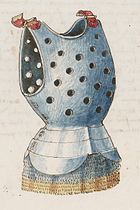Codpiece


A codpiece (from Middle English cod 'scrotum') is a triangular piece that attached to the front of men's hose, covering the fly. It may be held in place by ties or buttons. It was an important fashion item of European clothing during the 15th–16th centuries, in the 16th century becoming a firm upwards-pointing projection based on a stiff material such as boiled leather, or in plate armour, steel.
In the modern era, similar clothing pieces are worn in the leather subculture, and in performance costumes, such as for rock and metal musicians. A similar device with rigid construction, an athletic cup, is used as protective gear for male athletes.
In European fashion
[edit]From the ancient world there are extant depictions of articles of clothing designed to cover just the male genitalia; for example, archaeological recovery at Minoan Knossos on Crete has yielded figurines, some of whom wear only a garment covering the male genitalia.[1] However, the codpiece, per se, appeared in everyday European fashion for men only many centuries later, associated with hose and trousers.

In 14th century European fashions, men's hose were two separate legs worn over linen drawers, leaving a man's genitals covered only by a layer of the linen drawers. As the century wore on and men's hemline fashion rose, the hose became longer and joined at the centre back, there rising to the waist, but remaining open at the centre front. Further shortening of the cote or doublet fashion resulted in more prominence of the genitals; this area would then be covered with a triangular material called a codpiece.[3] Most of what is known about the cut, fit, and materials used for Renaissance codpieces is through portraits, clothing inventories, receipts for payments and tailor cutting guides.
As time passed, codpieces became shaped and padded to emphasize rather than to conceal the penis.
Such excessive codpieces became an object of derision showered on outlandish fashions. The Renaissance author, François Rabelais, refers satirically to a book entitled On the Dignity of Codpieces, in the foreword to his 1532 book, The Histories of Gargantua and Pantagruel.[4]
This fashion reached its peak of size and decoration in the 1540s before falling out of use by the 1590s.

Suits of armor of the 16th century followed civilian fashion, and for a time, codpieces were a prominent addition to the full suits of armor.
A few examples of full suits of armor with codpieces are on display in museums today. The Metropolitan Museum of Art in New York City has one. The Higgins Armory[6] in Worcester, Massachusetts, also had an example on display until its close. The armor of Henry VIII displayed in the Tower of London has a codpiece as well.[7]
Examples of metal parts of such armor are depicted by Wendelin Boeheim in his 1890 publication on the history of weapons, Handbuch der Waffenkunde, which was published in Leipzig, Germany.[5]
Gallery
[edit]-
Portrait of Antonio Navagero (1565) with an accentuated codpiece, oil on canvas by Giovanni Battista Moroni, Pinacoteca di Brera, Milan
-
Charles V, Holy Roman Emperor, by Titian, 1533, shown wearing a codpiece with short doublet, Museo del Prado
See also
[edit]- Jockstrap
- Koteka, penis sheath used in Papua New Guinea
- Kynodesme
- Willy warmer
- 1500–1550 in fashion
- 1550–1600 in fashion
References
[edit]Notes
- ^ Hogan, C. Michael (22 December 2007). "Knossos Fieldnotes". The Modern Antiquatarian. Archived from the original on 9 April 2016. Retrieved 14 October 2018.
- ^ The Yorck Project (2002) 10.000 Meisterwerke der Malerei (DVD-ROM), distributed by DIRECTMEDIA Publishing GmbH. ISBN 3936122202.
- ^ Ridley, Jasper Godwin (1996). Tudor age. Woodstock: Overlook. p. 163. ISBN 978-0-87951-684-0 – via Internet Archive.
- ^ "Worlds of the Renaissance 2000 - Dina McArdle Project". Albertrabil.com. Archived from the original on 2004-01-21. Retrieved 2012-01-19.
- ^ a b Boeheim, Wendelin, Handbuch der Waffenkunde. Das Waffenwesen in seiner historischen Entwickelung vom Beginn des Mittelalters bis zum Ende des 18. Jahrhunderts. Seemanns kunstgewerbliche Handbücher. Vol. 7, ZDB-ID 53757-3. Seemann, Leipzig 1890.
- ^ John Grabenstein, "Archived copy". Archived from the original on 2016-10-12. Retrieved 2005-09-17.
{{cite web}}: CS1 maint: archived copy as title (link). - ^ Paddock, John Miles; Edge, David (1995). Arms & armor of the medieval knight: an illustrated history of weaponry in the Middle Ages (reprinted ed.). New York: Crescent Books. ISBN 978-0517103197.
Further reading
- Ashelford, Jane: The Art of Dress: Clothing and Society 1500–1914, Abrams, 1996. ISBN 0-8109-6317-5.
- Ashelford, Jane. The Visual History of Costume: The Sixteenth Century. 1983 edition (ISBN 0-89676-076-6), 1994 reprint (ISBN 0-7134-6828-9).
- Edge, David: Arms and Armor of Medieval Knights: An Illustrated History of Weaponry in the Middle Ages.
- Hearn, Karen, ed. Dynasties: Painting in Tudor and Jacobean England 1530–1630. New York: Rizzoli, 1995. ISBN 0-8478-1940-X.
- Bodemer, Brett: "Pantagruel's Seventh Chapter:The Title as Suspect Codpiece Archived 2011-06-29 at the Wayback Machine."
External links
[edit] Media related to Codpieces at Wikimedia Commons
Media related to Codpieces at Wikimedia Commons- Codpieces in art from The Guardian
- New York Times interview with a codpiece maker





